.....When
I was learning how to play pool there were no books, no videos,
no instructors and no leagues to play in. The best way to learn
was to watch. I was privileged to see some of the greatest and
some of the not so great. My purpose for publishing my pointers
insrtuctional column is not only to inpart pool knowledge to my
viewers but to share with the public what these great players from
the 1980s and 1990s looked like. Through my trusty Canon, for a
moment in time they are immortalized. Some are still here and some
are gone and I still remember the joy of watching them play.

CHALK IT UP TO EXPERIENCE
The
naked cue tip, how embarrassing...
A mis-step could lead to a mis-cue
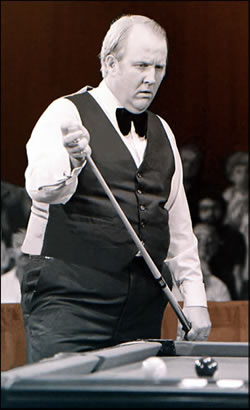 .....CHALKING
UP IS a much neglected art. Many amateurs and, believe it or not,
some pros, do not realize the importance of that seemingly minute
task. Chalking properly before each shot actually serves two purposes.
The most obvious is to prevent miscues. The second, more subtle
advantage t .....CHALKING
UP IS a much neglected art. Many amateurs and, believe it or not,
some pros, do not realize the importance of that seemingly minute
task. Chalking properly before each shot actually serves two purposes.
The most obvious is to prevent miscues. The second, more subtle
advantage t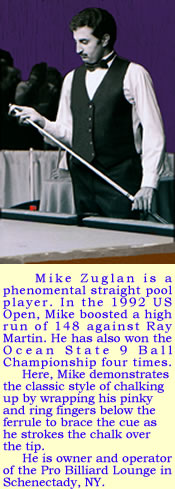 o
chalking is that it allows you to pace yourself and concentrate
during a game. o
chalking is that it allows you to pace yourself and concentrate
during a game.
.
....Chalk
is applied to the tip of the cue stick to increase the tip’s
friction as it contacts the smooth surface of the cue ball on a
non-center hit to avoid a ‘miscue’ or
unintentional slippage. Cue tip chalk was invented, according to
Wikipedia.org, by straight billiard pro William Spinks and chemist
William Hoskins in 1897. It’s made by crushing silica and
the abrasive substance corundum or aluminum oxide into a powder
and adding a binder glue and dye. Each manufacturer has their own
mixture of ingredients but the harder, drier compounds are generally
preferred by most players.
.
.....A lot
of players simply spin the cue tip inside the chalk, which creates
a huge crater. They succeed only in getting chalk all over the
ferrule, and their clothes, instead of evenly coating the top and
sides of the cue tip. They think it’s
cool to drill the stick
like Tom  Cruise did in the film, “The
Color of Money”. Cruise did in the film, “The
Color of Money”.
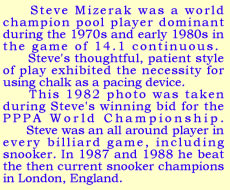 But
actually it’s the “road to disaster” in a Groucho
Marx movie.
Try this some time. Take a cue stick off the rack in a pool room.
Wipe off any chalk on the tip with a tissue. Then take a piece
of chalk and spin the cue tip around inside the chalk. Feels good
and looks cool, right? Now take a good look at the tip of the cue.
Notice that the very center has no chalk on it and neither do the
edges of the tip. Isn’t that where you need
chalk the most? But
actually it’s the “road to disaster” in a Groucho
Marx movie.
Try this some time. Take a cue stick off the rack in a pool room.
Wipe off any chalk on the tip with a tissue. Then take a piece
of chalk and spin the cue tip around inside the chalk. Feels good
and looks cool, right? Now take a good look at the tip of the cue.
Notice that the very center has no chalk on it and neither do the
edges of the tip. Isn’t that where you need
chalk the most?
.
 .....Here
is the correct way to chalk up. Begin by placing the cue stick
in the hand that feels more comfortable. Note how Steve Mizerak,
Mike Zuglan, Nick Varner and Jimmy Fusco hold the piece of chalk
in three fingers while wrapping the other two just below the ferrule
to brace the cue. They now begin to stroke the chalk across
the top of the cue, slightly tilting the chalk and continuing to stroke the
chalk around the edge of the tip. The tip has now been chalked
evenly and they are confident that they won’t miscue. So
instead of drilling the tip into the chalk, you need to caress
the chalk across the cue tip. .....Here
is the correct way to chalk up. Begin by placing the cue stick
in the hand that feels more comfortable. Note how Steve Mizerak,
Mike Zuglan, Nick Varner and Jimmy Fusco hold the piece of chalk
in three fingers while wrapping the other two just below the ferrule
to brace the cue. They now begin to stroke the chalk across
the top of the cue, slightly tilting the chalk and continuing to stroke the
chalk around the edge of the tip. The tip has now been chalked
evenly and they are confident that they won’t miscue. So
instead of drilling the tip into the chalk, you need to caress
the chalk across the cue tip.
Master
Billiard Cue Chalk is the most popular cue tip chalk on the market
today and my personal favorite. Made by Tweeten Fibre of Chicago,
Master chalk coats pool cue tips smoothly and evenly for a sure
grip of the cue ball when applying English, that is, side spin.
Master chalk will not cake or flake like other chalk brands. Although
Master Billiard Cue Chalk is available in a variety of colors,
I prefer the blue. I have successfully used other colors, like
red and green which match the table cloth, but being from the old
school, blue is my favorite.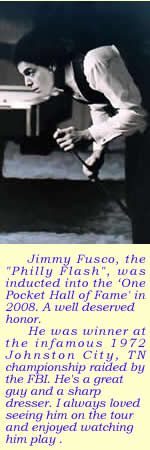
…..A common misnomer is that chalk
can also be used as “baby
powder” to smooth your stroke. In reality, chalk is too abrasive
to be used like talc so it defeats the purpose of trying to sleek
the motion of the cue stick through your fingers. A better idea
is to put some baby powder in a small vial and carry it with you
in your cue case or pocket.
.....Occasionally,
I go out with friends to a tavern that has a pool table. I don’t
bring my cue stick, but I always have my Scotch Brite general purpose
pot scrubber, my tapper and a piece of Masters chalk with me. The
Scotch Brite square is made from high quality synthetic fibers
that are crimped and heat set to develop a strong open web, mineral
and resin pad. It works great for cleaning up and smoothing out
a house stick but I wouldn’t use it on my own two piece cue.
Watch out for scouring pads made of plastic; they’re out
there. They do nothing to clean up a cue stick. For my own cue
I use the smooth stroke sand papers which are extremely thin. They
just remove the dirt and grim, not the wood. But, dear reader, I digress…
.....Look
at the concentration, Jimmy Fusco has on his face as
he chalks his cue. For that matter, all the players are looking
intensely at the table while chalking up. They’re relaxed
and yet absorbed on making the next shot and getting position.
They are viewing the pattern set out in front of them. This same
step of stroking the chalk across the cue tip should be taken after
each shot. (Visit Jimmy and Mike Fusco as they meet Dorothy Wise as she enters the PPPA Hall of Fame.)
...Repetition
helps you stay in a good groove. Like the smart players they are,
Mizerak, Zuglan, Varner and Fusco all know not to waste this crucial
opportunity to collect themselves during an
important match.
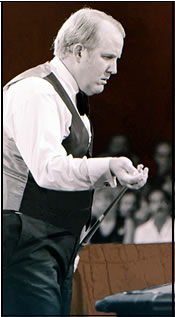
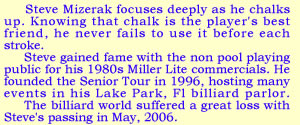 
http://www.tweeten.us/chalk.html
…..I
cannot stress the importance of setting a pace for yourself, no
matter what the sport. Like a basketball player dribbles the ball
and the baseball player takes his practice swings, the pool player
chalks his cue to give him/her time to think. I tell my students
to walk to the other side of the table to get that ‘other’ piece
of chalk (rather than the one right in front of them) which forces
them to see a new perspective on the table. I encourage them to
look at the pattern from a different angle, rather than cementing
their feet in the position they’re standing. That little
piece of chalk is a tool to help you mentally strategize your game.
Like any good technician, use your tools of the trade to multitask
for a more productive outcome.

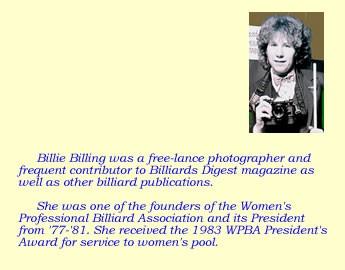
. ....Pool
Pointer Archives
.....1. Closed
Half-Bridge
... .2. Look
Before You Leap
.....3. Mechanically
Inclined
.....4. Keep
a Level Cue
.....5. Double or Nothing
.....6. Chalk It Up
.........Tune
in for more Pointer articles coming
your way each month..

|

